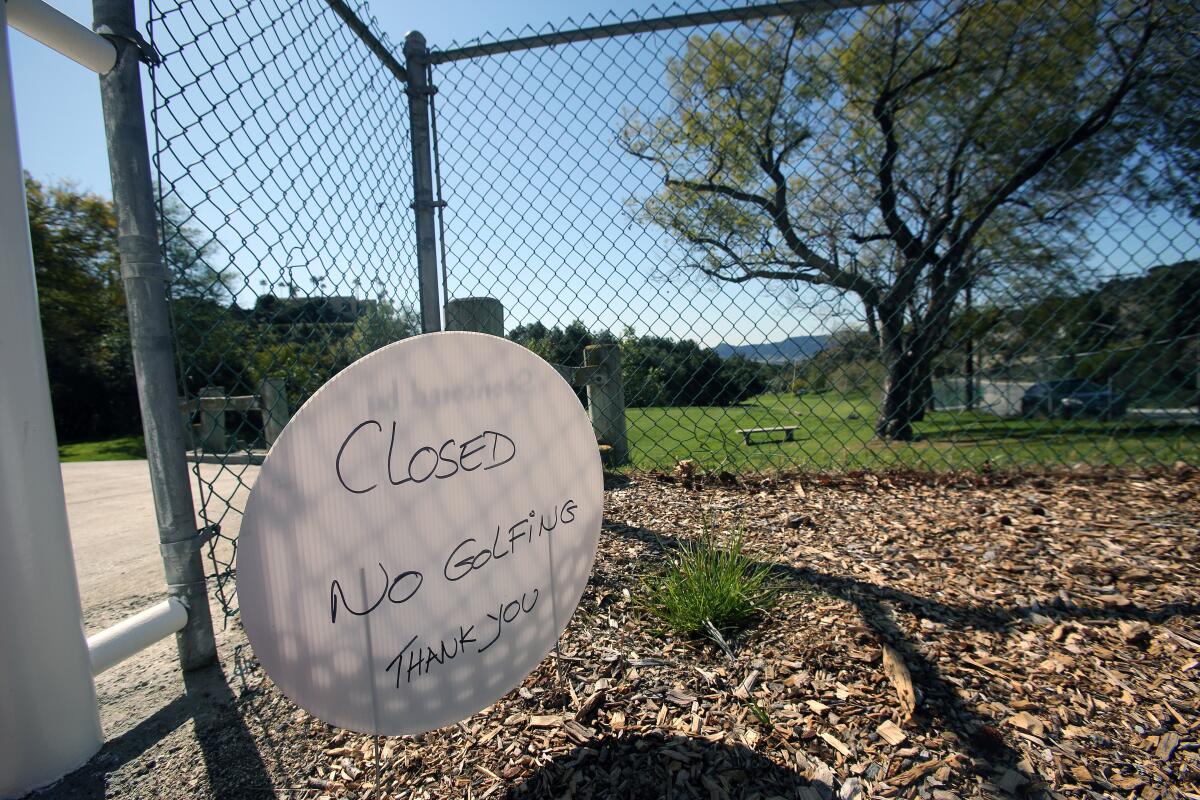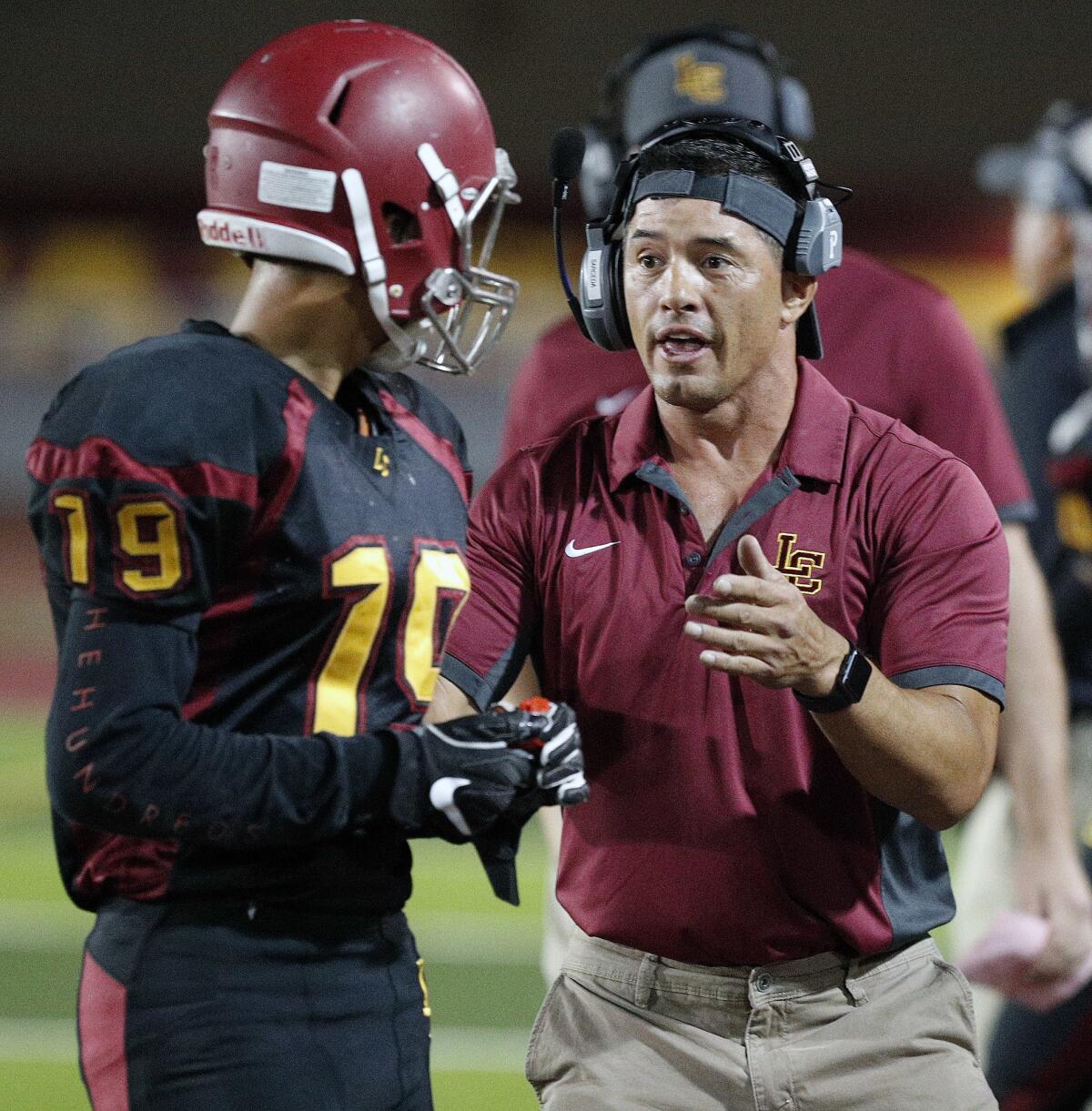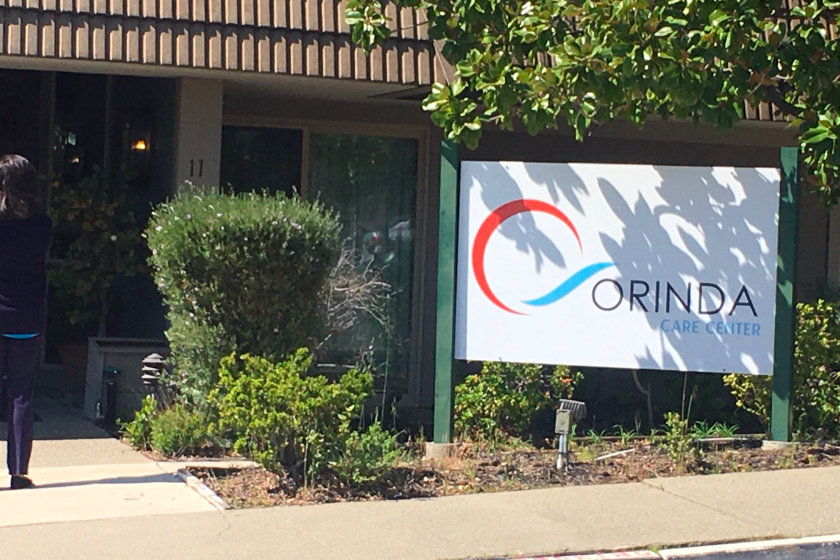Personal trainers, coaches forced to adapt amid financial strain from coronavirus outbreak

It’s near 6 p.m. on a Tuesday as La Cañada High football coach Jason Sarceda sets up space in his home in Eagle Rock, preparing to go live on his Instagram account.
At least 15 users have trickled into his live sessions as he sets aside exercise bands and dumbbells and turns his speakers on louder.
With a black pullover hoodie and gray shorts, Sarceda tells his viewers to begin stretching as his dog Charlie prances in front of his camera.
“We’re working out today!” Sarceda said.
Just one week before, L.A. Mayor Eric Garcetti ordered the closure of many businesses in an attempt to slow the spread of the COVID-19 outbreak.
This included gyms and fitness centers.
Soon after, counties across the Southland followed suit, and Sarceda’s private gym on Foothill Boulevard shut its doors.
But that didn’t stop Sarceda from motivating others to stay active.
Promoting his one-hour workout session, he reached out to 1,098 of his followers on his Instagram account, strut_fitness_studio, as well as his dedicated clientele on the video conferencing app Zoom.
As Sarceda continues struggling to get Charlie out of his way, many of his viewers offer positive feedback.
“This is so awesome, thanks for doing this,” said one viewer.
“So cool,” said another.

Sarceda is facing what many personal fitness instructors are experiencing with the closure of gyms and recreation areas around the state.
Instructors and coaches in the area have seen their finances drastically reduced because of the pandemic’s impact on everyday life.
The closure of parks, recreation areas and fitness centers have left them scrambling to adjust to a new normal and to find a way to compensate for their losses.
Two days after Garcetti’s order, California Governor Gavin Newsom issued a statewide “Stay At Home” order that permitted only essential businesses to remain open.
Slowly thereafter, L.A. County closed down public places despite heavy foot traffic around parks, beaches and other areas.
This restricted many instructors and coaches and forced them to interact with their clientele from home, as is the case with Sarceda.
In Sarceda’s case, the closure of his small private fitness center Strut Fitness Studio in La Cañada, has halted his in-person one-on-one and group sessions with clients.
Sarceda is also unable to generate revenue from other trainers who rent out space to work with their clients.
“It’s a really tough situation and a tough time for me,” said Sarceda, who has also been unable to work with his Spartans football team after all sports activities were halted because of the coronavirus. “Financially, I have zero income.
“But I look at the rest of America and a lot of us are in the same boat. My heart is just in the right place to help people at this point and keep them motivated and encouraged knowing that, basically, I have no stream of income.”
Strut Fitness Studio was thriving before the closure, Sarceda said. It was routinely busy with appointments and new sign-ups. Sarceda consistently marketed his studio on Instagram, which brought in new clients from word-of-mouth.
But with so many individuals also feeling the hit, Sarceda took it upon himself to motivate others to stay positive.
“I’m not going to sit here and struggle,” Sarceda said. “I depend on training people, but, under these difficult times, I think it’s more important to show humanity and just be there for other people, care for them and try my best to encourage them to stay healthy and stay fit. My hope is that after all this, people will recognize me in that state and come back and use my services when the time permits. I just try to pay it forward as I can.”
Though the fitness studio is closed and instructions have switched over to online streams, Sarceda still has a loyal group of clients that continue to pay for his services. However, he has refrained from charging clients on Zoom, as well as viewers on Instagram.
“If people decide to donate, it’s up to them,” Sarceda said. “I just want to keep on moving and keep people motivated and stay active.”
Studio fees vary.
Clients pay by specific training or group sessions, and workouts are scheduled on appointments with trainers. Group classes are normally $125 a month with unlimited access to sessions.
“In general, for the Zoom meetings, there are people that are still on their month-to-month payments that are paying,” Sarceda said. “Then there’s other people that I open it up to because I need to get some kind of positivity going for people. There are some people that are getting it for free, and that’s OK. As long as it’s motivating people.”
In Glendale, the closure of gyms shut down operations at the District Sports Performance gym facility, which relocated from Woodland Hills two years ago.

The space is owned personal trainer AJ Moosa, who had a solid influx of athletic clients who work out and train for their respective sports.
Moosa, who opened up District SP four years ago and has recently taken more of a managerial role at the gym, oversees about 15 athletes, notably Burbank High football players Aram Araradian, Kuba Raymond and Brandon Pena.
Since the facility is a private gym, most of the revenue comes from other trainers renting out space for personal instructions, Moosa said.
“Financially, it’s been a big hit not only for me, but for everybody,” said Moosa, who has been a personal trainer since 2014. “The facility is the main thing for me. It’s our bread and butter.”
The facility eats up $9,000 per month with utilities and insurance costs, but with eviction and rents frozen for the time being, Moosa has at least some financial wiggle room.
Though renters in Glendale will have six months to pay back their landlords after the city halted evictions of residential and commercial tenants on March 19, Moosa is still worried about his bill once everything clears up.
“If this goes on for a few more months and we come out of it, it’s like, ‘alright, now you owe $30,000 or $40,000 in rent on top of what you are already paying for,’” Moosa said. “How are we suppose to come out of that? We’re not generating double the amount of rent right now in order to pay double.”
Membership costs vary, beginning at $50 for beginners and up to $500 for those more advanced. However, most of the facility’s income comes from other trainers renting out the space.
“That means the facility is in a tough spot because now all of the revenue we’re getting from the trainers, we’re not getting that anymore,” Moosa said. “Our personal training clients that were coming in aren’t coming in anymore. We go from having revenue coming in to having nothing coming in.”
As trainers began to transition their personal instruction from the gym to their home, they are also trying to figure out ways to remain viable in this trying time.
The facility members played with the idea of online courses, but the idea was soon scrapped when taking into consideration most of the clients who utilize equipment in the gym might not have access to that same equipment at home.
“When we come out of this, we’re going to struggle, so I’m thinking of doing some type of fundraiser or something to get us back,” Moosa said.
On March 27, Newsom ordered a statewide ban on evictions for renters, briefly giving renters relief for two months.
About six miles north, the closure of Scholl Canyon Golf and Tennis Club has restricted private tennis lessons for St. Francis High and Flintridge Sacred Heart Academy tennis coach Ron Zambrano.
Though his income has taken a hit, Zambrano has replaced his time as a private instructor with a position in the printing industry at the U.S. Label Corp. in Burbank.
Before becoming a private tennis instructor, Zambrano was a freelance graphic designer. Just a week prior to the state mandate, his friend at the print shop were seeking an extra hand.
Zambrano eased back into the printing profession, but his hours have since jumped to full-time.
Luckily, Zambrano, who averaged $70 an hour teaching 25 hours a week through his private tennis instructions, saved up enough money to sustain himself for the next two or three months. However, if the restrictions aren’t lifted by the summer, his finances will take a big hit.
“We’re just going to see how we’re going to restart all of this,” said Zambrano, who also hosts an annual youth tennis camp in the summer. “We still don’t know. We hope this finishes before June or July. Where we make most of our money is the summertime. Summer is when we make half of our income, I think.”
Just weeks ago, Zambrano saw his St. Francis tennis season come to a halt in the middle of Mission League play. Shortly after, his private lessons at Scholl Canyon also stopped.
“I miss the kids,” Zambrano said. “I miss the high school season. We had a pretty decent team. But now, everything’s at home.”
Like Scholl Canyon, the Hansen Dam Golf Course in Pacoima suffered the same fate March 23.
While most golf activites were still going on as public parks were shutting down in the early stages of the pandemic, Burroughs girls’ soccer coach Brady Riggs had already taken a step back from in-person golf instructions two weeks prior to the county-wide closure.
Riggs has experience with providing online instruction since his virtual lessons were mixed with his demonstrations on the driving range.
But to move 100% of his lessons digitally is a different story.
The longtime golf instructor, who is among the Top 100 instructors according to Golf Magazine and who regularly contributes writing to the publication, has various ways of conducting virtual lessons.
Like Sarceda, Riggs offers tips and advice on his Instagram page @RedGoat, and, just recently, on his new golf podcast.
“I’m a coach,” Riggs said. “It’s what I do and it’s what I love to do. If I’m not doing it getting paid, I’m doing it for free somewhere. Golf’s been my life.”
Most of the time though, his clients either text him clips of their questions or the two will FaceTime a lesson.
With such a wide-range of clients, from beginners to professionals, amateurs to college players and from Southern California to across the Atlantic, Riggs is able to connect with clients whether they are at home or on the course.
“This is how we usually communicate when players are away,” Riggs said. “They’re sending videos of their swing and telling me what’s happening. It’s not an unusual way to communicate with players, especially with the better players like the ones playing pro for a living.
“It could be unusual for the amateurs because they’re usually coming in person for lessons rather than traveling on a tour or playing college golf. It’s an effective way to help people while they’re still able to get out. It’s doable. It’s not ideal, but better than nothing.”
Normally, lessons run for an hour, but online instruction varies, ranging from 15-20 minutes or 30-40 minutes. Instruction fees also vary considering the skill level of the golfer.
“It’s unusual to work with people this way, so I wouldn’t want to block myself into a certain rate for ‘x’-amount of time,” Riggs said. “Sometimes, a half hour is way too much and you don’t need to spend that much time with someone. Sometimes, 45 minutes feels like it goes by quick, so why don’t we keep going?”
The silver lining to this experience is the outreach Riggs builds while doing online instructions. People from all over the country send him clips for advice.
On of his clients lives in London.
“That’s kind of the neat part about doing online,” Riggs said. “You have access to a lot of people that you may not have otherwise taught. There’s some upside to it. Obviously, we’d all like to be at our place of business where we’re comfortable, but we have to keep helping people and we have to keep our business going. We have to do what we have to do.”
Though Riggs has an alternative way to manage his income, it’s still not enough.
Riggs usually spends an entire day at the range, teaching about four to six golfers. Mixed with his online clientele, that number grows to 10-12 individuals.
That number is now cut in half.
“I don’t think any coach right now is able to make the amount of money they were making before this happened,” Riggs said. “I’m just grateful I’m able to do this at all.”
Public areas were also shutdown in the Burbank area, including access to Memorial Field and Ralph Foy Park, among others, where Burroughs football wide receiver coach Erick Hernandez held small clinics.
The cost of isn’t as detrimental for Hernandez, a 2016 Burroughs High graduate who has been a member of the Indians’ football coaching staff.
Since January, Hernandez has coached a group of kids on Wednesdays and Sundays.
On average, Hernandez trained a small group of four people on Wednesday evenings at Ralph Foy Park, and on Sundays, he teamed up with a quarterback coach to oversee a larger group at Memorial Field.
Joining him in sessions were collegiate athletes from Pasadena City College and L.A. Valley College, with a mix of middle school and high school kids from Pasadena to the San Fernando Valley. However, most of his clientele are athletes from Burbank and Glendale.
Hernandez, who is pursuing a business degree at Cal State Northridge, is also working on getting his coaching credential to achieve his goal of coaching in college after playing two years at Pennsylvania University and one year at Humboldt State.
Hernandez charges an affordable $10 for his clinics, so he hasn’t felt as much of the impact as others. The money primarily goes to fill up his gas tank.
“I’m still going to school, so I still have to drive to school and whatnot, but I’m not going to break the pockets of any kid or parents who’s trying to just get better,” Hernandez said.
Even before the shutdown, Hernandez kept in contact with his clients, sending them clips of wide receiver fundamentals in a group chat, which included footage ranging from social media videos to game tapes.
Since the mandate, Hernandez has found ways to improve his lessons, picking the brains of coaches at the collegiate and professional levels through social media and online clinics.
Online clinics provide tips for Hernandez, and social media gives him the chance to reach out to wide receiver coaches, notably from Ohio State and the Chicago Bears.
“It’s opened up more time for me to do these things,” Hernandez said. “I’ve actually learned a lot and you’re making connections as well. It’s been pretty beneficial for me, but I think pretty soon it’s going to get kind of annoying because I can’t go outside and put it to use.”
But with the transition to off-field training, Hernandez faces the challenge of not being able to apply those lessons in real time.
What the group misses out on is the close relationship and bond developed with one another. Despite that, his athletes still update him with clips of their own.
“I miss doing that and I want to get going,” Hernandez said. “It’s hard to do that, but there’s ways to do it like online, making videos or presentations. It’s hard to put it out there and send it to all of them because we’re not all together. I’m really just ready to get going with the high school football season.”
